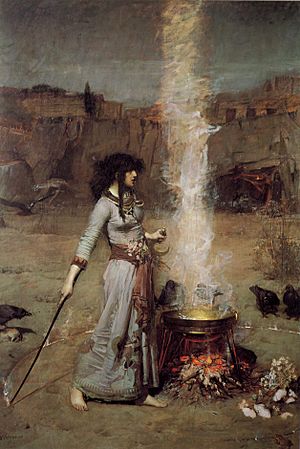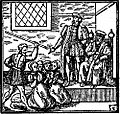Witchcraft facts for kids

Witchcraft is the belief in and use of magical powers. These powers might be used for healing, for seeing into the future, or sometimes for causing harm. People have believed in magic for a very long time, even since the earliest human cultures. Many people still believe in it today.
A person who practices witchcraft is often called a witch. While the term "witch" is often used for women, men who practice witchcraft might be called wizards or sorcerers. Sometimes, people believed that witches had special knowledge about herbs or plants and could use them to help sick people.
Contents
Witchcraft in Ancient Times
In ancient times, people who had magical powers were often seen as witches or sorcerers. There are many stories about witches in Greek mythology. For example, Circe was a powerful sorceress in Homer's famous story, Odyssey. Circe was known for using special potions to cast spells on visitors to her home. She could even turn people into pigs!
Witchcraft in the Middle Ages
During the Middle Ages, beliefs about witchcraft started to change, especially in Europe. Over time, witchcraft began to be seen as an enemy of Christianity. The Catholic Church believed that witchcraft was connected to evil and the devil.
Witch-Hunts and Trials
In the late Middle Ages and early Modern period in Europe, many people, including Catholic and Protestant leaders, became very afraid of witches. This fear led to large witch-hunts in many places. People widely believed that the devil was using witches to try and harm Christianity.
Because of these fears, thousands of people were accused of witchcraft. Many were put in prison, and some were even killed. Most of the people accused were women, as it was commonly believed that women were more likely to be witches.
During witch trials, people looked for ways to prove if someone was a witch. One strange test was called 'swimming a witch'. The accused person would be thrown into a river with their hands tied. If they sank, they were considered innocent. But if they floated, they were believed to be guilty of witchcraft.
Modern Witchcraft: Wicca
In the early 20th century, a new system of beliefs developed that is sometimes called modern witchcraft. This belief system is known as Wicca. Wicca is a modern religion that often focuses on nature, peace, and the worship of a God and Goddess. It is different from the older, fearful ideas of witchcraft from the past.
Images for kids
-
A painting in the Rila Monastery in Bulgaria, showing disapproval of witchcraft
-
A Shona traditional healer (n'anga) in Zimbabwe
-
Examination of a Witch by T. H. Matteson, inspired by the Salem witch trials
-
An old illustration of witches, from Daemonologie (1597) by King James VI
See also
 In Spanish: Brujería para niños
In Spanish: Brujería para niños









